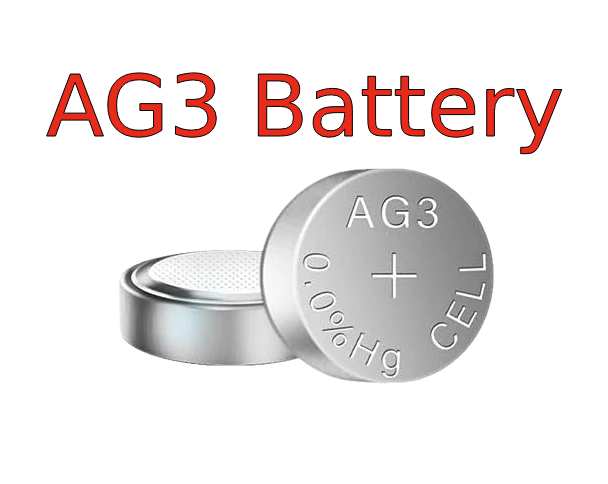

AG3 Battery Overview and Usage Guide
Catalog
Overview of AG3 (LR41) BatteriesWhat Is an AG3 Battery?AG3 Battery EquivalentsFeaturesApplicationsHow to Extend the Life of an AG3 BatteryEnvironmental Impact of AG3 BatteriesFinal ThoughtsFrequently Asked Questions (FAQs)Overview of AG3 (LR41) Batteries
In today’s world, electronic devices are a part of everyday life. From watches and calculators to toy cars and remote controls, many of these compact gadgets rely on small button cell batteries to operate efficiently.
Among them, the AG3 battery stands out for its small size, affordability, and broad compatibility with numerous electronic devices. These miniature batteries are crucial for powering products that would be impractical to run using larger or bulkier power sources.
The AG3 battery has become one of the most common choices for small electronics, offering reliable performance in a wide range of applications. Understanding its specifications, features, and equivalents is key to maintaining optimal performance and extending device life.
In this article, we’ll explore the characteristics and benefits of the AG3 battery, discuss its equivalent models, and offer practical advice on how to make the most of its lifespan.

What Is an AG3 Battery?
The AG3 battery, also referred to as LR41, 192, or GP192, is a miniature alkaline button cell measuring approximately 7.9 mm in diameter and 3.6 mm in height. It delivers a nominal voltage of 1.5V, making it suitable for devices that draw low power.
Thanks to its small size and reliable output, the AG3 battery is commonly found in everyday devices such as watches, small toys, laser pointers, digital thermometers, and various medical instruments.
AG3 batteries also offer a relatively long shelf life—typically up to three years, depending on storage conditions. This makes them a practical option for products that don’t require frequent battery replacements.
In many cases, AG3 batteries can be interchanged with SR41, 384, or 392 batteries, which have nearly identical dimensions and voltage ratings. However, some of these equivalents—like the SR41—use silver oxide chemistry, offering slightly longer life and more stable voltage. The ability to use compatible alternatives ensures that your device continues functioning smoothly even if the exact battery type isn’t available.
AG3 Battery Equivalents
Because of their reliability and versatility, AG3 batteries are sold under several different names depending on the manufacturer or region. The most common equivalent designation is LR41. Despite the different labeling, AG3 and LR41 batteries are practically identical in size, voltage (1.5V), and chemistry.
Other common equivalents include 192, GP192, SR41, SR736, 384, and 392. All share the same general specifications—7.9 mm in diameter, 3.6 mm in height, and 1.5 volts—even though some use slightly different materials or compositions.
While most equivalents perform similarly, certain applications may require a specific chemistry or voltage stability. For this reason, it’s best to check your device’s requirements before choosing a substitute.
Applications
AG3 batteries and their equivalents provide consistent, dependable power for a wide range of compact electronics. They are commonly used in:
- Watches and clocks
- Calculators
- Digital thermometers
- Laser pointers
- Small toys
- Medical instruments
Their small form factor, reliability, and easy availability make them a go-to choice for low-drain portable devices.
Features
AG3, also known as LR41, is a compact alkaline button cell that delivers dependable power in a small package. Its main features include:
Compact Size:
With a diameter of 7.9 mm and a height of 3.6 mm, the AG3 battery is perfectly suited for compact electronic devices where space is limited. Its small form factor allows it to fit neatly into watches, calculators, and small toys.
1.5V Nominal Voltage:
Operating at a standard voltage of 1.5 volts, the AG3 provides steady power for low-drain electronics. This consistent voltage output ensures reliable performance throughout its lifespan.
Alkaline Chemistry:
The AG3 uses alkaline chemistry, known for its good energy density and long shelf life. This makes it ideal for devices that don’t require frequent battery changes but still need a stable, long-lasting power source.
Reliable Performance:
These batteries are built to deliver consistent, dependable power from start to finish. Devices like watches, calculators, and medical instruments depend on this reliability to function smoothly without interruption.
Wide Range of Applications:
From small toys and digital thermometers to laser pointers and medical devices, AG3 batteries are used across a variety of everyday electronics due to their compact size and trustworthy performance.
Long Shelf Life:
AG3 batteries can be stored for extended periods without significant loss of performance—typically up to three years. This makes them an excellent choice for emergency kits, backup batteries, or devices used infrequently.
Applications
Watches and Clocks
AG3 batteries are commonly used to power both wristwatches and wall clocks. Their stable output ensures precise timekeeping in quartz movements. Whether in a personal watch or a wall-mounted clock, AG3 batteries provide dependable power for accurate, long-term operation.
Calculators and Electronic Gadgets
Compact gadgets such as calculators, digital thermometers, and small measuring tools rely on AG3 batteries for consistent performance. They help these devices deliver accurate readings and calculations in schools, offices, laboratories, and homes.
Medical Devices
AG3 batteries are widely used in medical equipment like glucose meters and pulse oximeters. Their stable voltage supports accurate readings—vital for patient health monitoring. Their long life and reliability make them an excellent choice for medical professionals and home users alike.
Toys and Games
From light-up toys to handheld gaming devices, AG3 batteries bring toys to life with sound, motion, and lights. Their compact size and reliable energy output ensure fun, uninterrupted play for children and adults.
Remote Controls
AG3 batteries power small remote controls, such as key fobs and compact IR transmitters. They make it easy to control devices like car locks, small appliances, and entertainment systems from a distance with smooth, responsive operation.
Flashlights and LED Lights
AG3 batteries are perfect for powering mini flashlights and LED keychain lights. Their small size makes them ideal for portable lighting solutions—great for travel, emergencies, or late-night reading.
Electronic Jewelry and Accessories
Fashion accessories with built-in LEDs or light-up effects often use AG3 batteries for illumination. These batteries provide subtle, reliable power for glowing earrings, rings, or pins, adding a touch of sparkle and style.
Laser Pointers
AG3 batteries are commonly used in laser pointers for presentations, classrooms, and business meetings. They deliver steady power for bright, precise laser output, helping speakers capture attention and highlight key details with ease.
How to Extend the Life of an AG3 Battery
Getting the most out of your AG3 batteries helps you save money and ensure reliable device performance. Here are some practical tips to help extend their lifespan:
1. Proper Storage
- Keep batteries in a cool, dry place: Avoid high humidity and extreme temperatures, as these can cause batteries to discharge faster or even leak. Store them in their original packaging until use.
- Avoid heat exposure: Never store batteries in hot environments, such as inside a car or near heaters, as heat can shorten battery life.
2. Smart Device Usage
- Switch devices off when not in use: Many small devices powered by AG3 batteries—like calculators or toys—can continue drawing power even when idle. Always turn them off after use.
- Remove batteries during long periods of inactivity: If you won’t be using a device for a while, take the batteries out. This prevents slow discharge and protects against potential corrosion inside the device.
3. Choose Quality Batteries
- Buy from trusted brands: Quality matters. Reputable manufacturers provide longer-lasting, more reliable batteries. Cheaper or generic alternatives may not perform consistently and could have a shorter lifespan.
Environmental Impact of AG3 Batteries
Like most disposable batteries, AG3 batteries pose certain environmental concerns. Although small and seemingly harmless, they may contain toxic substances such as mercury and cadmium, which can harm the environment if not handled properly.
Here are some important considerations:
1. Proper Disposal
Never throw used AG3 batteries in regular household waste. Many local governments and recycling centers offer battery collection programs for button cells. Using these programs ensures hazardous materials are disposed of safely and helps reduce pollution.
2. Recycling
Some electronics retailers and service centers provide battery recycling options. Participating in these programs helps minimize the environmental impact of single-use batteries and supports responsible waste management.
3. Eco-Friendly Alternatives
Consider using rechargeable batteries or devices powered by renewable energy sources whenever possible. These options reduce reliance on disposable batteries and promote a more sustainable approach to energy use.
Final Thoughts
AG3 batteries remain a key power source for low-drain electronic devices thanks to their compact size, consistent performance, and wide range of uses. Their equivalents—LR41, 192, GP192, SR41, SR736, 384, and 392—share the same specifications and can be used interchangeably in most applications.
From watches and clocks to medical instruments, toys, and remote controls, the AG3 battery delivers dependable energy wherever reliable, long-lasting power is needed.
By understanding the features and compatible alternatives of the AG3 battery, users can ensure their devices continue to perform at their best across different industries and applications.
For more information or to explore available options, visit JMBom.com.
Frequently Asked Questions (FAQs)
1. Are AG3 and 392 batteries the same?
Not exactly. AG3 and 392 batteries serve similar purposes but differ in several key aspects:
- Chemical Composition: AG3 batteries use alkaline chemistry, while 392 batteries are silver oxide.
- Voltage: AG3 operates at 1.5V, whereas 392 typically runs at 1.55V.
- Capacity: Thanks to the silver oxide composition, 392 batteries generally last longer and provide a more stable output.
- Application: AG3 batteries are ideal for low-drain devices, while 392 batteries are better suited for high-drain applications that require steady, consistent power.
In most cases, a 392 can replace an AG3 without noticeably affecting device performance, though it’s always best to check the device specifications first.
2. What are the differences between AG3 and LR41 batteries?
AG3 and LR41 batteries are essentially the same in size, voltage, and chemistry, but there are slight naming differences:
- Naming Conventions: “AG3” is a generic designation commonly used in Asia, while “LR41” is the international IEC name recognized worldwide.
- Brand Labeling: Depending on the manufacturer, you may see the battery labeled as either AG3 or LR41, though their specifications are identical.
- Applications: Both can be used interchangeably in devices that require 1.5V button cells—such as watches, calculators, and small electronics. Always confirm compatibility in your device’s manual before replacing.
3. How can I extend the life of an AG3 battery?
Here are a few easy ways to get the most out of your AG3 batteries:
- Store properly: Keep batteries in a cool, dry place away from heat and humidity.
- Turn devices off when not in use: Prevent unnecessary power drain by switching off devices after use.
- Choose quality brands: Always buy from reputable manufacturers to ensure longer-lasting performance and reliability.
Subscribe to JMBom Electronics !













